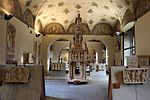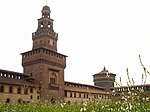Applied Arts Collection, Milan

The Applied Arts Collection of Milan (Raccolte d’Arte Applicata di Milano in Italian) is located in the Sforza Castle museum complex under the management of the municipality of Milan, Italy. The museum is divided into several sections with particular emphasis on jewelry, ivories, pottery and art glass. The ceramic collection includes medieval, Renaissance and Baroque pottery, a maiolica group with pieces from 17th-century Lodi and Milan, and a collection of European chinaware and earthenware. The collection of artistic glass includes the Gonzaga Cup, made of crystal clear glass and decorated with a pattern of small golden flowers and the Gonzaga coat of arm with a quadripartite black eagle on a white background. In the Sala Della Balla is the Arazzi Trivulzio, a series of twelve tapestries representing the different months of the years. Their design is based on drawings by the Italian painter Bramantino.
Excerpt from the Wikipedia article Applied Arts Collection, Milan (License: CC BY-SA 3.0, Authors, Images).Applied Arts Collection, Milan
Piazza Castello, Milan Municipio 1
Geographical coordinates (GPS) Address Nearby Places Show on map
Geographical coordinates (GPS)
| Latitude | Longitude |
|---|---|
| N 45.469619444444 ° | E 9.1804305555556 ° |
Address
Piazza Castello
20123 Milan, Municipio 1
Lombardy, Italy
Open on Google Maps










